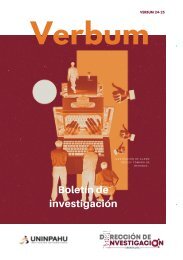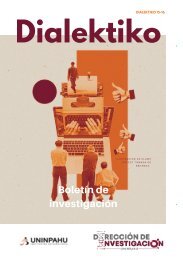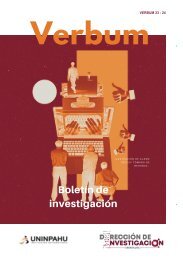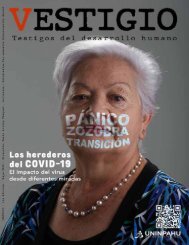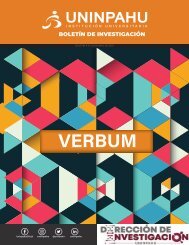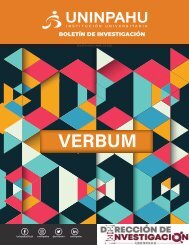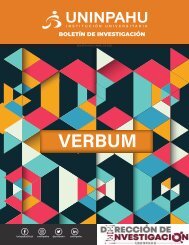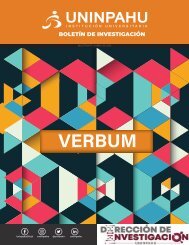Revista UNINPAHU No 9
Revista de investigación UNINPAHU No 9
Revista de investigación UNINPAHU No 9
Create successful ePaper yourself
Turn your PDF publications into a flip-book with our unique Google optimized e-Paper software.
24 Pp 23 - 31. Nº 9, octubre de 2013<br />
Introduction<br />
In the article titled “Lessons on Teaching and<br />
Learning in History from Paul’s Pen” (2000),<br />
Leinhardt (2000) introduces the notion of<br />
‘educational opportunity’ as a mix of significant<br />
learning experiences. Inquiring about what might<br />
be taught and learned in classrooms, and what<br />
might be the best way to go through in reaching<br />
a really fruitful history instruction at school,<br />
she opens up an important discussion upon<br />
issues of meaningful pedagogical experiences.<br />
‘Educational opportunity’ in this sense calls our<br />
attention to the potential value and meaning of<br />
the so-called informal learning instruction.<br />
In the practice of teaching history Leinhardt<br />
(2000) pursues the question: “Instructionally,<br />
what are the richest mixes of educational<br />
processes, such as physical experiences (field<br />
trips, films), textual analysis and integration<br />
(reading and writing from historical sources),<br />
and performance (debates, theatre) in which<br />
students should engage?” (p. 224). As a history<br />
teacher, she is interested in looking for productive<br />
combinations of educational processes, textual<br />
analysis, and performance-events that students<br />
could be involved in, so teachers can get the best<br />
instructional benefit.<br />
Reflecting on the in-classroom teaching-learning<br />
praxis, she states that there are many other spaces<br />
where educational experiences and significant<br />
learning can take place. She referrers to the<br />
venues of museums and mass media (Leinhardt<br />
,2000, p.243), to cite one or two examples, but<br />
Historical National Archives visits could be<br />
included in the list as well, as a resourceful<br />
venue for history learning involving rewarding<br />
pedagogical strategies.<br />
This was a research project that explored the<br />
kind of pedagogical possibilities that collective<br />
remembrance mediated by practices of drama<br />
in education could offer to the work of social<br />
memory. At stake in the study was a dramaremembrance<br />
project that attempted to link<br />
significant historical learning with critical<br />
remembrance through the classroom drama<br />
praxis. We worked on the possibility of the school,<br />
and particularly the drama class, as a terrain<br />
within which the formation of a community of<br />
memory was possible, and a process of drama<br />
linked with personal and collective remembrance<br />
could take place.<br />
It was a collective-collaborative research process<br />
in a pedagogical environment in which to<br />
work out the ethical accountabilities of the<br />
exploration of the past. The memory work we<br />
were particularly interested in was comprised<br />
of the social acknowledgement of previously<br />
forgotten histories and their contemporary rearticulation<br />
in specific social and political settings;<br />
the class, the school, and the community. From<br />
an artistic and an educational point of view, the<br />
project attempted to offer alternative pedagogies,<br />
different ways of learning to make history and<br />
social studies curriculum more relevant to<br />
students and educational institutions.<br />
The research was implemented in the <strong>No</strong>rmal-<br />
Distrital Maria Montessori School, in Bogotá,<br />
Colombia-South America. Participantresearchers<br />
worked through questions regarding<br />
the pedagogical meaning of personal memories,<br />
and the public remembrance of the story of the<br />
Colombian Afro-descendant Manuel Saturio<br />
Valencia, one of the last prisoners to be executed<br />
by the State before capital punishment was<br />
eliminated from Colombia in 1910. Saturio’s<br />
account as many other Colombian minority<br />
groups’ accounts, still struggles to overcome a<br />
legacy of oblivion and historical erasure, since the<br />
story of his life and subsequent execution remains<br />
little known in the collective Colombian history.<br />
A visit to the Colombian National History<br />
Archive was set up as a final research step to<br />
facilitate participants gaining direct contact<br />
with archival documents, particularly a 1907<br />
telegram announcing Saturio’s execution. It was<br />
a research strategy chosen as an experiential<br />
way to give students a more vivid sense of the<br />
reality of the past.<br />
Trajectories of the touch of<br />
the past<br />
“Lo que más me gusto, que no aprendimos<br />
con la cátedra tradicional sino que también




